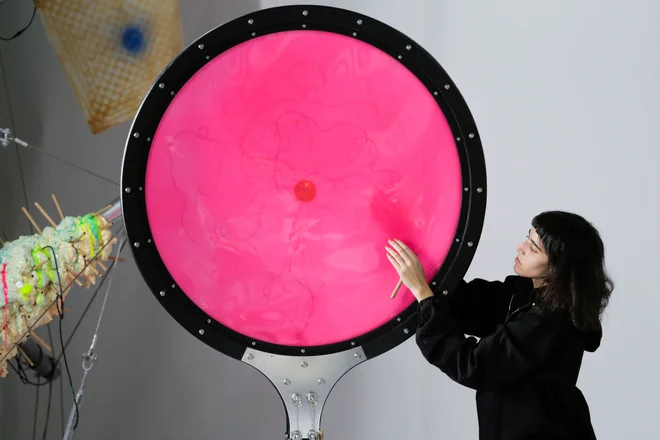Chilean artist invites you to listen to the whole being

By sounding installation Practitioner (Rehearsal Room) over Ljubljana Biennial Biennial It is a chilean interdisciplinary artist and researcher Nicole L’Huillier (1985) living in Germany. She received her doctorate from media arts and science at the prestigious Massachusetts Institute (MIT), and is involved in how to use sounds and vibrations as basic building materials.
How can the sound form our sense of who we are and how we connect with others, in ways that images or words may not be able to do?
In a world in which everything is in constant fluctuation, sounds and vibrations are essential for thinking and life. The reality is a vibrational membrane in which everything is in a constant resonant relationship. Sounds and vibrations teach us, as inseparable forces, about the world of dynamics, insecurity, constant transformation and thus indeterminacy. Life is group Jam Session In progress, and when we tune in with this idea, we learn the importance of attention and how essential it is to listen, accept, vibrate, resonate and transduce.
In the vibration mode of thinking, everything is membrane, everything – including us – behaves like a drum.
The sound vibrates our bones, shakes our meat, moves through us and beyond us as an invisible vibrational membrane. On the contrary, images run the risk of adulating the oculocentric views of the world, which maintain a certain distance and surface objectivity. The sound refers to deep -subjective immersion in immeasurable and noisy, where disorders and loss of clarity can be very fertile soil. In this sound universe, of course, words are important, but not only in a static way that relies solely on language and interpretation, but also because of the transductive and resonant capabilities of these energies that can reveal other languages and other codes, flashing languages, blinking codes.
At the heart of the sound installationPractitioner They are so -called dream drums. What are they and how do they work?
Drum drums are sculpture instruments with elastic membranes that act as microphones and oscillation spaces. They respond to touch, voice and vibration and convert the sound into sound. These sounds are digitally treated and reintroduced into the space, forming an environment tuned to brain frequencies associated with relaxation, meditation and dreaming. We play them as instruments and become essential elements Jam sessions. As interfaces, they listen and transmit – they become contact points between bodies, machines, sounds and space. They are instruments of collectivity and interfaces between areas of awake and dream life. They are part of a larger feedback loop that enables co -creation between humans and machines and the logic of dreams so that we can practice reality together.
Experiencing sound in community environments is always transformed for Nicole L’Huillier. Photo: Jimmy Day
In the installation, the drum is described as a threshold between the worlds. What do you think this instrument special?
The drum is a membrane – a communication border, a barrier that is also a bridge. It converts the blow into the tone, movement into resonance. It symbolically represents the heart, the creative potential of the beat, the first sound we hear in the uterus. Soundly offers both rhythm and spaciousness, and its vibrations were used in various cultures to excite trance, travel and healing. My drums are technology portals – their simplicity and resonance are a huge ability to transform.
Here the gesture becomes an echo where we listen not only to sound, but also the spaces it opens. Personally, the drum seems very important to me because it was the first instrument I played as a child and became my language. I have not played it for years and I miss him very much, although I was constantly discovering deeper diaales with membranes. In the vibration mode of thinking, everything is membrane, everything – including us – behaves like a drum.
Visitors become co -creators. Why is audience involvement important in your work and what do you hope people will take away from it?
Collaboration is fundamental because the resonance is not passive – it is an act of co -system. Practitioner It is a space of collective improvisation in which the boundaries between the artwork and the audience are blurred. I want people to experience vibration connection and to make work a step towards a co -created space of relationships. It is important to me that visitors explore resonant ideas and languages and how their presence shapes the fields that surround them.
The interplay of art, science and technology is also characteristic of your work in general.
In my opinion, these intersections allow for new hybrid languages - new tools, not only sound but also learning. However, it is also important to move away from the hegemonic and categorical concepts of science and to add tools and to infect methodologies to reveal other ways of getting to know and being in this world that tend to pluriver and nurture imagination. By participating in such projects, I do not want to quantify creativity, but I want to explore and learn from specific scientific tools to connect them to other tools and logic and play with their limitations and potentials. I think the future has always been in the blurring of categorical dividing lines between disciplines, logic and fields.






